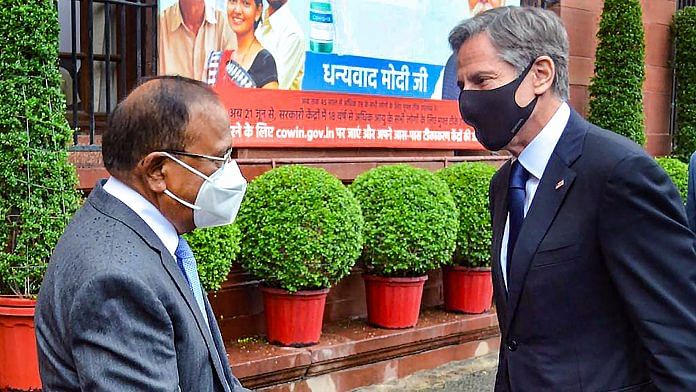US Secretary of State Antony Blinken had a busy schedule in New Delhi. His itinerary included a visit to New Delhi’s Tibet House, a cultural centre of His Holiness the Dalai Lama. His meetings with Prime Minister Narendra Modi and External Affairs Minister S. Jaishankar covered issues ranging from Covid challenges to climate change. Blinken’s office had put out the agenda well in advance and made it clear that the short visit will include discussions on “continued cooperation on COVID-19 response efforts, Indo-Pacific engagement, shared regional security interests, shared democratic values, and addressing the climate crisis”.
Around the same time, in a similar visit, US Deputy Secretary of State Wendy Sherman traveled to China where she met with officials including State Councilor and Foreign Minister Wang Yi.
But the similarity ends here. Except for the proximity of the dates of the two visits, the agenda, priorities and the tone and tenor of the meetings have gone on a very different and uneven keel.
Also read: Biden’s US is done engaging with China. This is what India should do now
Louder China, repetitive US
The US administration made it apparent that Sherman’s visit to China is part of the ongoing efforts to normalise relations with Beijing. The Deputy Secretary’s office clearly indicated that the discussions comprise the US’ willingness to hold “candid exchanges with PRC officials to advance U.S. interests and values and to responsibly manage the relationship.” Sherman’s to-do list also included discussions on areas where the US had serious concerns about China’s actions, as well as areas where US-China interests align.
The US acknowledged that much of what it has done in the initial months of the Joe Biden administration has been primarily to test the various propositions and options in dealing with China. President Biden had spoken to President Xi Jinping on broader issues, leaving the thorny ones to his aides. US National Security Advisor (NSA) Jacob Sullivan had met with the Director of the Office of the Central Commission for Foreign Affairs, Yang Jiechi, and other senior People’s Republic of China (PRC) officials. Blinken too had spoken to Jiechi and stressed that the US will continue to stand up for human rights and democratic values, including in Xinjiang, Tibet, and Hong Kong.
It was evident that the Donald Trump administration sought to engage with China on an equal footing. China, on the other hand, attempted to usurp America’s leadership mantle through power posturing in the economic, technological and geopolitical arena with strides much larger than the global and regional stakeholders could comprehend. Biden’s team, which inherited the trade war scenario, made it clear that the US wants a healthy competition with China in a situation where rules of engagement are clearly defined and enforced, and where there are guard rails to ensure that “competition does not spill over into something more dangerous, at worst, conflict.”
These curtain raisers gave enough time to Beijing to sharpen its claws and ‘give a piece of its mind to the Americans.’
Although the White House made it clear that it does not consider China as an adversary and wants no conflict, China’s Vice Foreign Minister Xie Feng took a serious note of the earlier briefings and said that the US was “demonizing” his country because it was seen as an “imaginary enemy.” The four-hour meeting between Sherman and Chinese officials in the north-eastern port city of Tianjin came at a time when Beijing had imposed sanctions on several US individuals and organisations, including former Commerce Secretary Wilbur Ross.
Also read: India, US reaffirm ‘democratic traditions’, ties as Blinken sends message to China from Delhi
Delhi must make itself heard
In contrast to his deputy’s China visit, Blinken’s India visit was as pleasant as the weather in New Delhi on his arrival, and needed no diplomatic umbrella to shield himself from reprimands. Much to the disappointment of a small, insignificant, but vocal, section of ‘whatever Modi does is wrong’ brigade, Blinken did not raise the issue of human rights during his talks with his Indian hosts. Like President Biden, Blinken too can be credited with possession of deep knowledge of India and the challenges that India-US relations have faced in the last five to six decades.
But there is little doubt that New Delhi needs to inform the US of its disappointment in relation to Washington’s policy on selective sanctions that suits the US but deeply hurts India’s interests, especially in Iran and Myanmar. The US withdrawal from Afghanistan has opened up a host of security issues for New Delhi.
The next round of Quad security dialogue will happen soon where the four countries will take stock of the current situation post-US withdrawal from Afghanistan and the emerging challenges in the Indo-Pacific region. The Chinese flagship programmes under the Belt and Road Initiative (BRI) are showing their true colours of being a security and strategic outreach behind the economic smokescreen.
While the G7 has rolled out an ambitious B3W (Build Back Better World) initiative, much like the famous Marshall Plan, it is unlikely to produce results unless New Delhi is seriously involved in it. Besides, the US unilaterally announced the formation of a new “Quad”, which includes Afghanistan, Uzbekistan, Pakistan, and the US, for “Regional Support for Afghanistan-Peace Process and Post Settlement”. It is not only a laughable idea but an affront to India that such an arrangement should be made without including India, much less consulting. The occupants of the White House need to stop reading the book ‘How to make enemies and lose friends.’
The author is the former editor of ‘Organiser’. He tweets @seshadrichari. Views are personal.
(Edited by Prashant Dixit)






